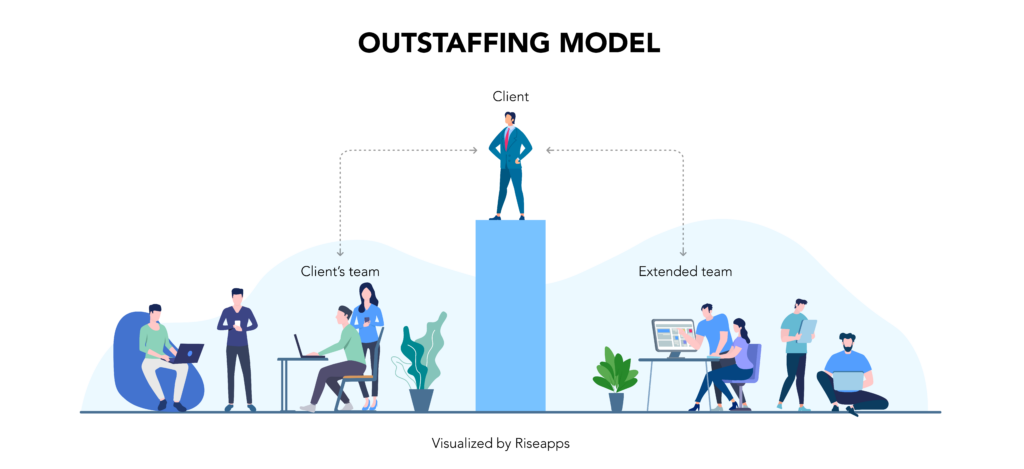
Digital nomads, freelancers, remote workers… All terms boil down to the same thing – more and more workers are leaving the physical office spaces and starting to work from their homes, cafes, beaches or similar. Although traditional offices are not even close to death, it can certainly be said that they are geared in that direction.
The coronavirus pandemic could also become a driver of the increased remote working in the future. It struck fast and hard and most of us had to hit the ground running to accommodate our attitudes and habits as we started working remotely. Along with increased work from home practice, there appeared a greater opportunity for outsourcing for foreign clients who are even millions of kilometres away.
The main reason for taking the outsourcing route in the past was the cost efficiency, but as time was passing, the standard outsourcing model started to show some shortcomings. Poor code quality, low motivation, lack of understanding of the bigger picture, late delivery and unpredictable MVPs were the most usual complaints.

As a response to this, in addition to traditional outsourcing, there has appeared the outstaffing model as a new approach to hiring remote talents. While still being very similar to outsourcing, outstaffing includes much more control on the client’s side by giving them the ability to manage remote workers directly, rather than through project managers or the other company. Moreover, outstaffing is a sort of indirect work engagement in which companies like Walter Code for example provide the services of staffing, retaining and overseeing full-time talents for international clients. Walter Code also takes care of legal aspects of cooperation, provides office space and IT support to the outstaffed team members, pays their salaries, provides additional education and mentoring of workers and some interesting employee perks, conducts HR processes, recruits new talents, etc.
There are numerous advantages of outstaffing, but here are the most crucial ones:
1. Process Optimization – Outstaffing gives a client an absolute insight in the team workload, daily activities, velocity and performance, without contacting an outsourcing vendor. In this way, companies are enabled to implement their creative ideas and improvements more easily, collecting the feedback of their team and taking their suggestions into account. In contrast to outsourcing, the power of a strong and creative team is present in outstaffing and has numerous benefits on the company performance. That is why, IT outstaffing best works for those tech companies that are primarily focused on quality and want to expand their current tech team as soon as possible keeping absolute control over their employees and projects. In the best of circumstances, the client company has tech know-how to manage the whole team (including the outstaffed members), while the outstaffing service vendor provides everything else and makes the whole process smoother and possible even in the long run. Still, it’s not unusual for clients to employ project managers together with the remote team through an outstaffing provider.
2. Product Quality – Remote work has changed, and a lot of the hiccups that occurred even a decade ago, are now eliminated. Companies are now able to hire the best employees in the world to work on their projects, despite the geographical distance. Transferring key business tasks to entire trained teams that are able to improve your business’ sales and product quality proven to be the best decisions for the majority of companies all over the world. The most important fact to be mentioned here is that the competition in the global market is rising, and in order to stay competitive, outstaffing companies are focusing a lot on their work quality as one of the major factors for the success in this business, along with service prices and process organization. That is why these companies are investing a lot to train their teams to ensure that quality remains high, implementing additional quality checks to assist the team putting outsourcing managers in place that will ensure quality remains superb.
3. Cost Efficiency – Using the outstaffing model, a company can have a remote team without opening a new company branch or a remote development office. As a client, you do not need to hire recruiters, lawyers, accountants, and facility managers — they are already a part of an outstaffing provider and will take care of operational work. Meanwhile, you can implement your internal corporate policies and culture using the existing infrastructure and expertise of the outstaffing provider.

Furthermore, even though both methods are based on remote working, there are a lot of differences between outsourcing and outstaffing. The crucial difference is that in outstaffing, the client directly communicates with the team, manages their tasks and is fully in charge of deadlines and product value (timely delivery of the product and code quality). On the other hand, in outsourcing, the outstaffing suppliers round out the whole process by managing the team by themself, planning and tracking activities that should lead to the successful delivery of the product. Furthermore, the vendor manages the tech team on a daily basis. In the majority of cases, the vendor will staff the team with their existing engineers. The mutual advantage of these two models of remote work operations is that they can fill the gap between employee supply and demand on the local market and solve the problem of the growing talent shortage present in the tech industry.
Finally, it can be concluded that both of these models are efficient enough, especially in the age of remote working and globalization which, combined with digitalization, causes the international labor market to become centralized. But, if we start observing the whole comparison from the angle of clients, it can be definitely said that the outstaffing model is a better option for long lasting, continuous projects. On the other side, all short-term projects are better to be done with an outsourcing approach, as it is much more cost efficient and does not require full time presence nor additional assistance of a client.